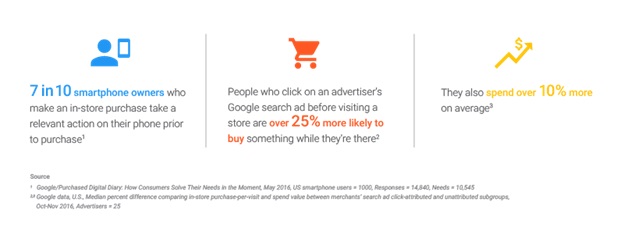Google is rolling out new analytics tools for marketers, designed to help them link online and offline behaviour, including attribution modelling, credit card data insights and YouTube ‘store visits’.

Matching up online and offline behaviour has often been described as “the holy grail” of marketing, but it also brings up new privacy concerns over the use of customer data.
Google is also launching promoted places and local inventory ads for retailers to promote special offers and show what’s in stock nearby. YouTube ads will also allow viewers to find a store via “location extensions”.
Store visits linked to YouTube views
Store visits measurement will now also be available for YouTube TrueView campaigns. Store visits measurement is currently available in 17 markets: US, Canada, Australia, United Kingdom, Germany, Netherlands, Italy, Brazil, Mexico, Spain, Japan, Sweden, Norway, Denmark, Austria and Switzerland.
“Today Google’s store visits measurement is the largest scale of its kind in the world, this product is powered by machine learning and unique data powered by our Google maps product,” said Dischler.
“We are also expanding our local ads formats to video, now you can go directly from a true view video ad on YouTube, which will now show directions, store business hours and more. More importantly we’ll have the same store visit technology for the video ads so advertisers can measure all the way from a video view to store visits,” he added.
However, should a region or country have users that are more privacy sensitive and choose not to share their Google Maps location data history, the store visit measurement product will be less effective.
Linking credit card data to online profiles
The move also means that Google is now tracking credit card transactions, both online and offline, matching them to online profiles.
Google’s new store sales measurement lets marketers measure in-store revenue in addition to the store visits sent by search and shopping ads.
As an example of how the new analytics works, Google can now prove that someone who saw an ad for a furniture store in Google Maps went and made a big purchase at that store. This would mean that the furniture store’s owner is much more likely to run more ads.

“We developed a new product in the US where advertisers will be able to measure store sales impact of online advertising automatically with no integration. If we have relevant sale information for an advertiser, it will just appear on their AdWords account, just like store visits and online conversions,” said Dischler.
“Our partnerships cover 70% of all credit and debit card transactions in the United State,” he added.
Marketers will also be able to add loyalty card data at the point of sales to Google AdWords, which will be available globally at launch according to Dischler.
Read more about Google’s new marketing analytics here
